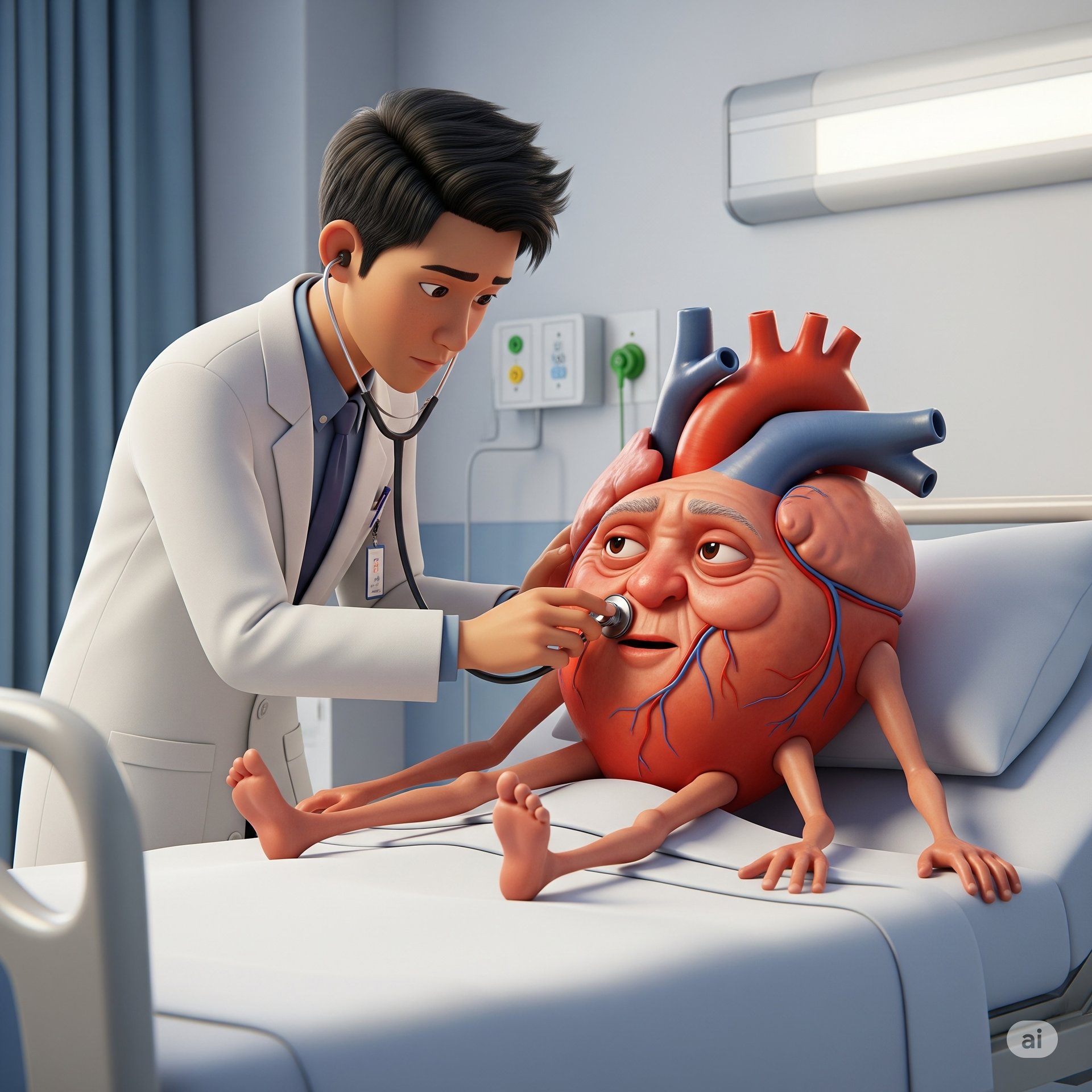THEMEDPRACTICALEXAM.COM

Cardiovascular System Examination: Auscultation
I. Patient Positioning for Optimal Auscultation
1. Supine Position
Routine position for the initial examination.
2. Left Lateral Decubitus Position
Best for auscultating the mitral area, particularly for picking up the low-pitched diastolic rumble of mitral stenosis.
Use the bell of the stethoscope for these low-pitched sounds.
3. Sitting, Leaning Forward (with Breath Held in Expiration)
Optimal for auscultating the aortic area, especially for detecting the high-pitched diastolic murmur of aortic regurgitation.
Use the diaphragm of the stethoscope in this position.
II. Auscultatory Areas and Technique
Auscultate all areas methodically, using both the diaphragm (for high-pitched sounds: S1, S2, ejection clicks, opening snaps, most murmurs) and the bell (for low-pitched sounds: S3, S4, and the diastolic rumble of mitral stenosis).
Main Auscultatory Areas
Mitral Area (Apex):
Located at the 5th intercostal space in the mid-clavicular line.
Commonly used to listen for mitral valve murmurs and heart sounds such as S1, S3, and S4.
Tricuspid Area:
Located at the left lower sternal border, typically at the 4th or 5th intercostal space.
Important for detecting tricuspid valve murmurs and right-sided heart sounds.
Aortic Area:
Located at the right 2nd intercostal space, next to the sternum.
Used for identifying murmurs of aortic stenosis and regurgitation.
Pulmonary Area:
Located at the left 2nd intercostal space, next to the sternum.
Useful for evaluating murmurs of the pulmonary valve.
Additional Auscultatory Areas (for Radiation and Specific Murmurs)
Left Axilla:
Listen here for the radiation of a mitral regurgitation murmur.
Neck (Carotid Arteries):
Check here for the radiation of an aortic stenosis murmur.
Suprasternal Notch:
Murmurs of aortic stenosis may also radiate to this area.
Back:
Listen over the upper back for murmurs associated with coarctation of the aorta and patent ductus arteriosus (PDA).
Epigastrium:
Sometimes abnormal heart sounds, especially from right-sided lesions or congenital defects, can be heard here.
Clinical Tips:
Always auscultate systematically, moving through all areas.
Adjust patient position as necessary to enhance specific sounds.
Carefully note the timing (systolic or diastolic), pitch, intensity, and radiation of abnormal sounds you hear.
Compare findings to what is expected in a normal heart for accurate assessment.
Heart Murmurs in Clinical Cardiology
Below is an organized overview of the principal cardiac murmurs, including their detailed description, site best heard, respiratory variation, radiation, auscultation tool (bell/diaphragm), and common clinical conditions.
1. Systolic Murmurs
a. Aortic Stenosis (AS)
Description: Ejection systolic, crescendo-decrescendo, harsh.
Site Best Heard: Right 2nd intercostal space (aortic area).
Respiratory Phase: Louder on expiration.
Radiation: To carotid arteries.
Auscultation Tool: Diaphragm.
Condition: Calcific aortic stenosis, bicuspid aortic valve, rheumatic heart disease.
b. Pulmonary Stenosis (PS)
Description: Ejection systolic, crescendo-decrescendo.
Site Best Heard: Left 2nd intercostal space (pulmonary area).
Respiratory Phase: Louder on inspiration.
Radiation: To left shoulder, rarely to neck.
Auscultation Tool: Diaphragm.
Condition: Congenital pulmonary stenosis, carcinoid syndrome.
c. Mitral Regurgitation (MR)
Description: Pansystolic (holosystolic), high-pitched, blowing.
Site Best Heard: Apex (5th ICS, midclavicular line).
Respiratory Phase: No significant respiratory variation.
Radiation: To left axilla.
Auscultation Tool: Diaphragm.
Condition: Rheumatic heart disease, infective endocarditis, mitral valve prolapse, myocardial infarction.
d. Tricuspid Regurgitation (TR)
Description: Pansystolic, blowing.
Site Best Heard: Lower left sternal border (tricuspid area).
Respiratory Phase: Louder on inspiration (Carvallo's sign).
Radiation: To right lower sternal border.
Auscultation Tool: Diaphragm.
Condition: Right ventricular dilatation/failure, infective endocarditis, carcinoid syndrome.
e. Mitral Valve Prolapse (MVP)
Description: Mid-systolic click followed by a late systolic murmur.
Site Best Heard: Apex.
Respiratory Phase: Murmur accentuated on standing.
Radiation: None or to axilla.
Auscultation Tool: Diaphragm.
Condition: Connective tissue disorders, congenital.
f. Ventricular Septal Defect (VSD)
Description: Harsh pansystolic murmur.
Site Best Heard: Lower left sternal border.
Respiratory Phase: No significant variation.
Radiation: Across the precordium.
Auscultation Tool: Diaphragm.
Condition: Congenital VSD.
2. Diastolic Murmurs
a. Mitral Stenosis (MS)
Description: Mid-diastolic, low-pitched rumble with opening snap.
Site Best Heard: Apex (in left lateral position).
Respiratory Phase: No significant variation.
Radiation: Rare, may extend to left sternal border.
Auscultation Tool: Bell.
Condition: Rheumatic heart disease.
b. Tricuspid Stenosis (TS)
Description: Mid-diastolic, rumbling.
Site Best Heard: Lower left sternal border (tricuspid area).
Respiratory Phase: Louder on inspiration.
Radiation: Rare.
Auscultation Tool: Bell.
Condition: Rheumatic fever, congenital, carcinoid syndrome.
c. Aortic Regurgitation (AR)
Description: Early diastolic, high-pitched, decrescendo.
Site Best Heard: Left sternal border (3rd-4th ICS), sometimes right sternal border.
Respiratory Phase: Louder on expiration, patient sitting forward.
Radiation: Along left sternal border.
Auscultation Tool: Diaphragm.
Condition: Rheumatic heart disease, infective endocarditis, Marfan syndrome.
d. Pulmonary Regurgitation (PR)
Description: Early diastolic, high-pitched, decrescendo ("Graham Steell" murmur when due to pulmonary hypertension).
Site Best Heard: Upper left sternal border.
Respiratory Phase: Louder on inspiration.
Radiation: Minimal.
Auscultation Tool: Diaphragm.
Condition: Pulmonary hypertension, infective endocarditis, congenital.
3. Continuous Murmurs
a. Patent Ductus Arteriosus (PDA)
Description: Continuous "machinery" murmur (peaks at S2).
Site Best Heard: Left infraclavicular area.
Respiratory Phase: May be louder on inspiration.
Radiation: Towards left clavicle.
Auscultation Tool: Diaphragm.
Condition: Congenital PDA.
4. Special/Other Murmurs
a. Innocent/Functional Murmurs
Description: Soft, short systolic ejection murmur.
Site Best Heard: Left sternal border or pulmonary area.
Respiratory Phase: Varies; may diminish with standing or Valsalva maneuver.
Radiation: None.
Auscultation Tool: Diaphragm.
Condition: Children, high output states (fever, anemia, pregnancy)4.
Clinical Pearls
Bell vs. Diaphragm: Low-pitched murmurs (e.g., mitral/tricuspid stenosis) are detected with the bell. High-pitched murmurs (e.g., regurgitant lesions) are best heard with the diaphragm51.
Respiratory Variation: Right-sided murmurs become louder during inspiration, left-sided during expiration16.
Radiation: Murmurs may radiate along blood flow direction or across the precordium depending on the valve and pathology